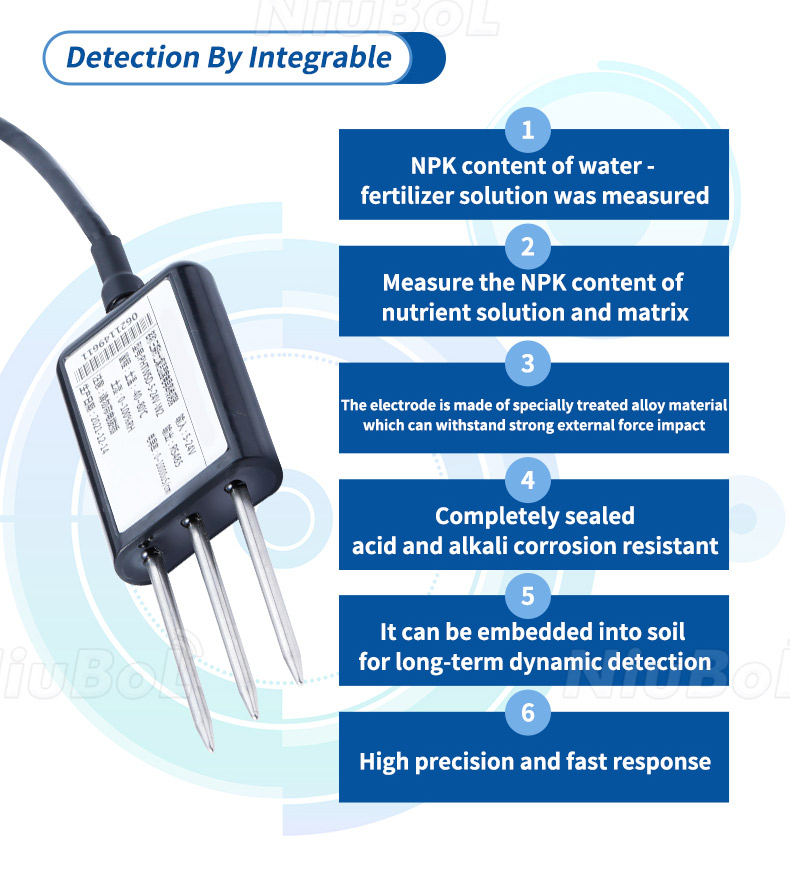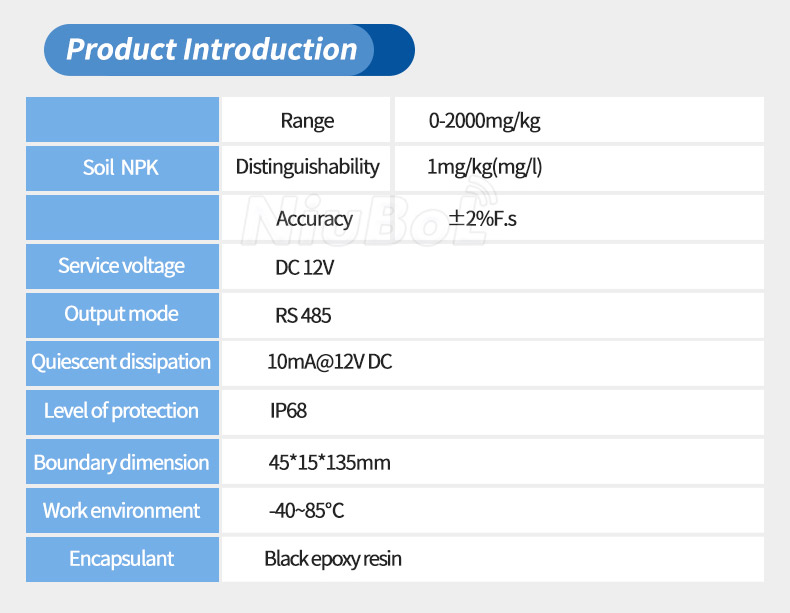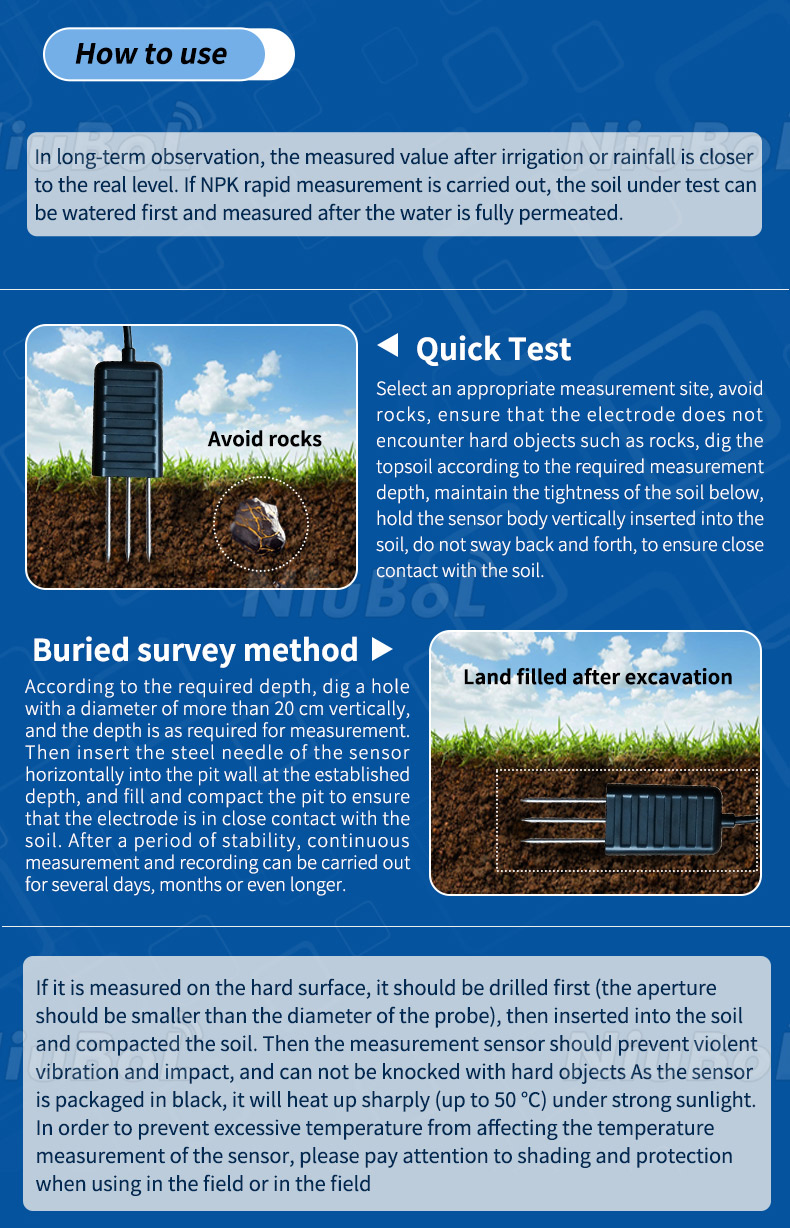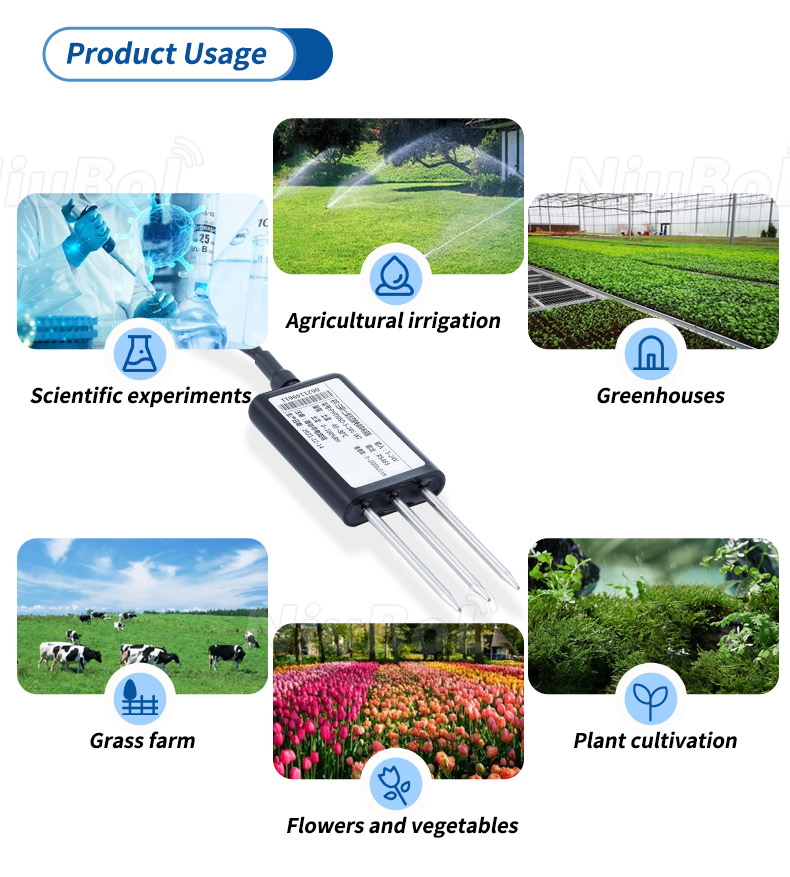

— Blogs —
—Products—
 Consumer hotline +8618073152920
Consumer hotline +8618073152920 WhatsApp:+8615367865107
Address:Room 102, District D, Houhu Industrial Park, Yuelu District, Changsha City, Hunan Province, China
Technical Support
Time:2023-09-13 15:31:12 Popularity:3441
Siol NPK sensor Introduction:
The soil NPK sensor is a device used to measure the levels of key nutrient elements nitrogen (N), phosphorus (P) and potassium (K) in the soil. It achieves accurate detection of NPK elemental concentrations in soil by employing a variety of techniques, such as spectral analysis, conductivity or ion-selective electrodes.
The NPK sensor converts the nutrient content of a soil sample into electrical signals, which are then collected and processed to produce data on the concentration of NPK elements in the soil. This data can help farmers understand the availability of nutrients in the soil so that they can target fertiliser applications to improve crop yield and quality.
Soil NPK sensors are essential tools in modern agricultural management. Understanding common issues, maintenance techniques, and proper installation requirements is crucial for users. This article aims to provide insights into troubleshooting, maintenance techniques, and installation requirements for soil NPK sensors, enabling users to effectively utilize and maintain these sensors.

1. NPK sensor Common Issues:
During the practical usage of soil NPK sensors, several common problems may arise, including:
- Signal loss or instability: This may be caused by poor cable connections, interference between the sensor and reading device, or a faulty sensor.
- Deviations in readings: If the measured values from the sensor significantly differ from the actual NPK levels in the soil, it could be due to calibration errors, sensor contamination, or aging.
- Leakage or seepage: This issue may result from deteriorated, damaged, or incorrectly installed seals.

2. Soil NPK sensor Maintenance Techniques:
When encountering issues with soil NPK sensors, the following maintenance techniques can be employed:
- Check cable connections: Ensure a proper connection between the sensor and reading device, clean the interfaces, and reinsert the cables.
- Perform calibration: If significant deviations occur in readings, calibration of the sensor using standard solutions can be carried out according to the manufacturer's guidelines.
- Clean and maintain: Regularly inspect and clean the sensor, avoiding the accumulation of dirt. Wipe the sensor surface with a cleaning solution or mild soapy water.
- Replace seals: Promptly replace damaged seals if leakage or seepage is detected, ensuring correct installation.

3. Installation Requirements:
Proper installation of soil NPK sensors is crucial for accurate measurements. The following requirements should be considered:
- Uniform soil insertion: Insert the sensor evenly into the soil, ensuring close contact with the surrounding soil to obtain accurate measurement results.
- Avoid contamination: Prior to installing the sensor, remove impurities or chemicals that may affect its accuracy.
- Secure the sensor: Utilize appropriate fixtures or brackets to secure the sensor in the desired location, preventing movement or tilting.
- Protect the cables: Safeguard the sensor cables against pressure, impacts, or other physical damage. Ensure the cables remain intact and avoid excessive tension.

Conclusion:
Understanding common issues, maintenance techniques, and installation requirements for soil NPK sensors is vital for users. By properly maintaining and promptly troubleshooting any problems, users can ensure the normal operation and data accuracy of soil NPK sensors, enhancing agricultural productivity and management. In cases where irreparable issues arise, it is recommended to contact the manufacturer or seek assistance from professionals.
Prev:Troubleshooting, Maintenance Techniques, and Installation Requirements of Soil Moisture Sensors
Next:Soil pH Sensor Troubleshooting, Repair Tips and Installation Requirements
Related recommendations
Sensors & Weather Stations Catalog
Agriculture Sensors and Weather Stations Catalog-NiuBoL.pdf
Weather Stations Catalog-NiuBoL.pdf
Related products
 Combined air temperature and relative humidity sensor
Combined air temperature and relative humidity sensor Soil Moisture Temperature sensor for irrigation
Soil Moisture Temperature sensor for irrigation Soil pH sensor RS485 soil Testing instrument soil ph meter for agriculture
Soil pH sensor RS485 soil Testing instrument soil ph meter for agriculture Wind Speed sensor Output Modbus/RS485/Analog/0-5V/4-20mA
Wind Speed sensor Output Modbus/RS485/Analog/0-5V/4-20mA Tipping bucket rain gauge for weather monitoring auto rainfall sensor RS485/Outdoor/stainless steel
Tipping bucket rain gauge for weather monitoring auto rainfall sensor RS485/Outdoor/stainless steel Pyranometer Solar Radiation Sensor 4-20mA/RS485
Pyranometer Solar Radiation Sensor 4-20mA/RS485
Screenshot, WhatsApp to identify the QR code
WhatsApp number:+8615367865107
(Click on WhatsApp to copy and add friends)
